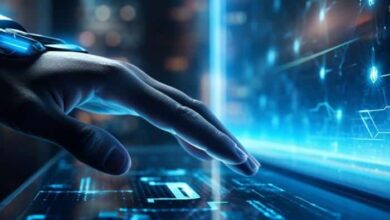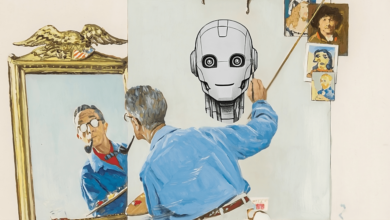AI Companies Turning Visual Data into Big Insights: The Power of Computer Vision



A lot of visual content, including photos, films, scans, streams and more, are generated and exchanged every second. From surveillance cameras to mobile phones to satellite photos, the world generates more visual data than ever. But there is a problem and it does not collect the data; It is all understanding.
That is where computer vision, supported by artificial intelligence, comes into play. This allows robots to ‘see’ and interpret visual things in the same way as people. However, they are faster and on a larger scale.
In this article we will see how visual data is converted into useful information and which organizations are at the forefront.
Why Computer Vision matters in Big Data Analytics
The aim of Computer Vision is to identify objects, patterns, deviations and insights that can be used to inform choices or prediction results. However, why does it matter in Big Data?
It is because visual content is now unprocessed data instead of just ‘media’. Consider traffic images, product images, medical scans or films that show consumer behavior. All this can be investigated for patterns, problems and possibilities. This data is huge, unorganized and unstructured, which is a challenge. That is where Computer Vision enters, so that the impossible is not only feasible, but also scalable.
How Computer Vision Visual Data translates into usable insights
The strength of computer vision is the ability to deconstruct complicated images in useful, measurable components.
It starts with obtaining or absorbing visual content, which can be everything, from a CT scan to a warehouse camera feed. The following is function -extraction, where AI models identify patterns, edges, objects or faces in an image. Algorithms then evaluate functions to achieve objectives, such as counting individuals, finding errors or recognizing gestures in visual data.
On the other hand, there are insights such as data, classifications, warnings or trend reports that organizations can use.
In the retail trade it can reveal how customers go through a store and what products they buy.
In the field of health care, the anomalies in X -rays can detect and help with a faster diagnosis.
In the logistics sector, the boxes can scan to ensure the right labeling or count inventory without human intervention.
Everything happens within a few seconds, if not real -time.
Leading AI companies that use Computer Vision to power Big Data with power
Now that we know how it functions, we let the ones investigate it effectively.
A Consultancy for Data Science Promotes computer vision from experiments to routine commercial intelligence. Among them are the following:
Clarifai
Clarifai offers a computer vision API and deep learning models for fast deployment in industries such as Defense, E-commerce and public safety. The tools include face recognition and object detection. Clarifai transforms large amounts of image and video data into structured insights for analysis.
Sensetime
Sensetime, with head office in Hong Kong, focuses on computer vision AI and solutions for face recognition. It uses large-scale video analysis to help smart cities, retail and autonomous driving. Their artificial intelligence offers real -time and historical insights at great speed and scale.
Scale ai
Scale AI helps companies to improve machine learning models by providing high-quality training data. It focuses on classifying visual data on a large scale for applications such as vehicles with military and driverless. Their approach helps AI systems to analyze images quickly and accurately in real-world settings.
Digital Sense AI
When you visit https://www.digitalsense.aiYou will discover that Digital Sense Computer Vision uses to solve practical problems in different sectors. They concentrate on whole solutions instead of just models. Through the integration of sensor, visual and transaction data, they develop plans that can be used. Their tools help companies to see problems such as product misplacement or equipment errors through smart visual analysis.
Challenges and considerations in visual data analyzes
Despite the progress, there are still problems working with visual data.
First, there is the issue of privacy and ethics. Face recognition and surveillance technology must be used in the right way, especially in public or sensitive environments. Then there is data quality – blurry photos, poor lighting and low resolution can all have an impact on accuracy. Moreover, even if real -time processing is very effective, it requires a lot of bandwidth and processing power.
Another important is interpretation. Even the most intelligent AI can misunderstand complicated visuals without human intervention. That is why most solutions still have people present for validation and quality control.
Advantages of visual analysis
It has various advantages for companies in different sectors, such as:
Faster decision -making
AI deals with data processing and analysis, so that organizations can quickly be gained in real -time insights. Traditional data processing techniques can take hours or even days, but AI-driven solutions can considerably shorten that time.
Raised accuracy
AI systems can process large amounts of data without human errors, resulting in more accurate findings. Whether it is about predicting market trends, identifying customer behavior or spotting potential risks, AI can offer very reliable results.
Improved user experience
AI Analytics solutions change complex data into visualisations, which means that technical and non-technical people can understand and act on findings. This democratizes data, so that decision makers can act quickly and decisively at all organizational levels.
Better allocation of resources
AI can help discover operational inefficiencies, so that companies can use resources better. Companies can optimize everything from stock management to personnel planning by visualizing operational data and using AI forecasts.
What is the next step: the future of visual data in Big Data Ecosystems
The future of visual data analysis is about faster, smarter and more interconnected solutions.
Edge Computing offers real -time analysis on devices such as smart cameras and telephones, without the need for cloud processing. In industries such as health care and logistics, this means faster decisions with less delay. Synthetic data is becoming increasingly popular as a training solution when actual data is sensitive.
As the computer vision becomes usual, AI companies will make full ecosystems that combine visual, numerical and behavioral data. It’s not just the tools.
Conclusion
We are surrounded by visual data, but interpreting is what it is worth. Computer vision transforms images into usable information. AI organizations use visual analyzes in their modern data strategy.




